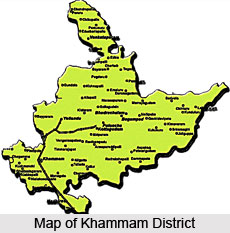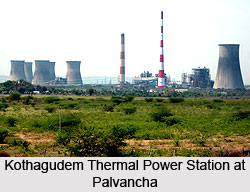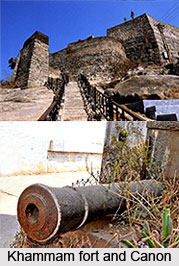 Khammam district is located in the south-eastern part of the Indian sub-continent and is an important district in the state of Telangana. Khammam town is the district headquarters. The district is known for its ethnic life style. It can be said that Khammam district has a strong historical lineage and at the same time in the present day the district also continues with its process of advancement.
Khammam district is located in the south-eastern part of the Indian sub-continent and is an important district in the state of Telangana. Khammam town is the district headquarters. The district is known for its ethnic life style. It can be said that Khammam district has a strong historical lineage and at the same time in the present day the district also continues with its process of advancement.
History of Khammam District
The name "Khammama" has been derived from `Narsimhadri` temple which was later known as "Stamba Sikharia". Later the "Stamba Sikharia" temple was known by the name `Stambadhri`. The vertical standing under the `Stambadhri" temple is known by the name "Kamba". It was believed that the town of Khammam has been named after this vertical rock and gradually the district was also named as Khammam. Till 1st October 1953, Khammam was part of Warangal. Later on five taluks of the Warangal district namely Khammam, Madhira, Yellandu, Burgampadu and Paloncha came together and the new district of Khammam was formed. In the year 1985, the Khammam district was divided into 46 mandals under four Revenue Divisions.
Geography of Khammam District
The geographical location of the district is between 16.45 degrees and 18.35 degrees north latitude and 79.47 degrees and 80.47 degrees east longitude. It encompasses an area of 16,029 square kilometers. Khammam is bounded by the Krishna district in the north, Godavari, Nalgonda and Warangal districts in the west and the state of Chhattisgarh borders Khammam towards the north. River Godavari is the main river of the district.
 The climatic and the soil conditions that are present in the district of Khammam is very suitable for a wide variety of horticultural crops like the Mango, Banana, Cashew, Coconut, Cocoa, Pepper, Areca nut and a lot more.
The climatic and the soil conditions that are present in the district of Khammam is very suitable for a wide variety of horticultural crops like the Mango, Banana, Cashew, Coconut, Cocoa, Pepper, Areca nut and a lot more.
Demography of Khammam District
When the district of Khammam was formed then it had a population of 8, 12,993 people but in the present age the population of Khammam district has increased greatly. The density of population in the district varies between 51 and 160 persons per square kilometer. The Scheduled Castes and the Scheduled Tribes form a sizeable portion of the population in Khammam. There are around 3, 60,154 Scheduled Castes and 5, 58,958 Scheduled Tribes in the district. Only 20 percent of the population in Khammam lives in the urban areas. The main tribes which comprise a major portion of the population of Khammam district are the Koyas, Lambadas and Kondareddis. The tribal population in Khammam account for 13.29 percent of the total population.
 Culture of Khammam District
Culture of Khammam District
The culture and religious tradition of the Khammam district are dominated by a number of influences. All the three religions namely the Hindus, the Muslims and the Christians have contributed in forming a mosaic culture of Khammam district. The tribal population of the Khammam district still follows their own traditions and ethnic life styles. It can be said that Khammam has a unique culture of its own and it has a strong flavour of history that is associated with the district.
Education in Khammam District
Education in the district of Khammam is well advanced. Special attention has been given towards primary as well as secondary education. Qualified teachers are being engaged to impart education to the children. Arrangements have been made by the district authorities to raise the standard of education. Special initiatives like mid-day meals, remedial classes, providing of study materials are practiced in Khammam. The district also has a number of colleges and institutes which are specialized in under-graduate as well as postgraduate courses.
Economy of Khammam District
Presently, Khammam district has an area equal to 84,583 hectares and the total horticultural production from the district is 4, 24, 506.000 Metric tons. Hence it is obvious that the district earns a large amount of revenue from its horticultural production. Apart from horticulture the activities which are practiced by the people of Khammam are agriculture and sericulture. The production and distribution of various kinds of flowers, fruits and their seeds is the major economic activity for the people of Khammam district and it is through this activity they make their living.
Tourism in Khammam District
The tourism industry in the Khammam district is well flourished. The major tourist attractions in the district are Khammam fort, Parnasala, Nelakondapalli, Kinnerasani Project, Palair, Peratalapalli Papi Kondalu, Somavaram, Kothagudem Thermal power station at Palvancha, Yanambailu and Kinnerasani Sanctuary. The religious places of interest in the district are Bhadrachalam Rama Temple, Jamalapuram temple, Jeelacheruvu Venkateswara temple, Kallur temple, Takkellapadu Sri Lalitha Parameswary temple, Garla Sangameswara temple, Kusumanchi temple, Peratalapalli Sangameswara temple, Sri Ramagiri Temple and the Khammam Laxmi Narasimha temple.
Visiting Information to Khammam District
Khammam Railway Station and Warangal Airport are the convenient ways of transportation to reach this place.






